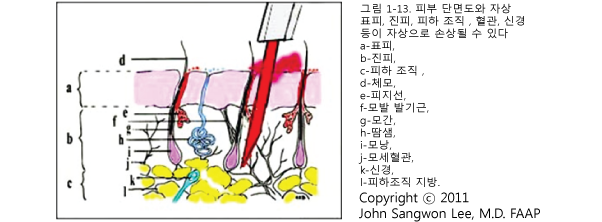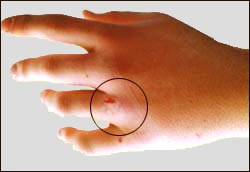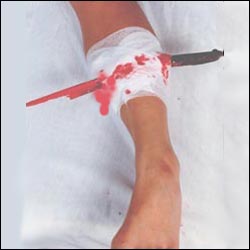Puncture wounds 자상
Cause of Puncture wounds
☞ In the US in 2005, 11,000,000 people received emergency room treatment for acute skin injuries.
More than 500,000 of them are burned, 7,300 thousand people were reincarnated, 2 million people have been treated for cuts and punctures It is said that 4,700,000 people are bitten by animals every year. source; NEJM September 2008. p.1037.
A piercing wound caused by piercing a part of the body with a sharp object such as a knife, nail, tree branch, splinter (small piece/splinter) or a gunshot wound is called a Puncture wound.
Rusty and unclean nails, sharp knives, sharp pieces of wood or glass can pierce hands and feet or other parts of the body.
Most cuts are caused by safety accidents, but they can also be caused by injuries by others or by self-injury.

a -epidermis, b-corium, c-subcutaneous tissue, d-hair, sebaceous gland, f- hair elevation muscle, g-hair body, h- sweat gland, i-hair follicle j-capillary vessels, k-peripheral nerve, l-fat in subcutaneous tissue
Type of Puncture wounds
- a stab wound in which the entire body of a stabbed body has fallen out of the body
- There are also stab wounds that have a stab-shaped entrance, a stab-penetrating path, and a stab-shaped exit like a piercing wound by a bullet.
- Some of the stabbed objects remain in the body, others are cut off,
- A stab wound in which the entire stabbed object remains in the body.
- Shallow stab wounds,
- A deep stab wound,
- There are penetrating cuts from one side of the torso to the other.
Symptoms signs of Puncture wounds
- Symptoms differ depending on the size and type of the stabbed object, the size of the cut, the type of the cut, the cause of the cut, and the part of the body where the cut occurred.

▴Photo 1-42. Fingers festered by a bacterial infection.
- The wounded area became festering, swollen, painful, and red.
- Copyright ⓒ2011 John Sangwon Lee, MD., FAAP
- Some small cuts are stabbed with sharp-end objects such as thorns, nails, and needles, and there are also very large cuts caused by piercing wounds or traffic accidents caused by gunshot wounds.
- A thorn, a needle, or a stab caused by a very small object may bleed a little or may not bleed, and the injured body part may not swell or hurt.
- When thorns are stuck, you can pull them out with tweezers.
- In general, bleeding from small cuts does not occur much, and there is no problem with health.
- Internal bleeding in the thoracic or abdominal cavity caused by a stab can be severe, and internal bleeding can cause shock or death
- If your hands or feet are stabbed by nails or sharp branches, you may bleed a little, hurt, and swell cut wounds.
- Bacterial infections in plantar cuts (plantar cuts) caused by nails can lead to cellulitis (see Plantar cuts).
- Osteomyelitis of the foot can also occur due to a cut on the sole of the foot caused by a nail piercing while wearing sneakers.
- When a foreign substance is in the cut wound, the infectious disease may develop locally within 2-3 days, and it may cause swelling and pain.
Treatment of puncture wounds
- Treatment of small cuts
- If part of the stabbed small object remains stuck in the cut wound, carefully pull out the stuck object as much as possible.
- After washing the cuts with soapy water, sterilize them with betadine solution disinfectant.
- Then, cover the cut with a disposable band-aid and observe.
- Alternatively, cover the cut wound with sterile gauze and fix the gauze with a band-aid, or wrap it with a bandage.
- In most cases, this first emergency treatment is performed by parents at the accident site.
- If parents are not confident to treat cuts at home as described above, or if they need follow-up cuts at the next step after taking first aid at home, receive treatment at a regular pediatrics department or hospital emergency room.

▴ Photo 1-43. Limbs or body with branches or sharp objects When the other part is deeply stabbed, the stabbed object hits the stabbed upper body.
- When stuck in place, stabbed objects are cut without instructions from a doctor. You must not pull it out of your upper body. Copyright ⓒ2013 John Sangwon Lee, MD., FAAP ‘
- Treatment of Puncture wounds
- If an arm, leg, or another part of the body is deeply punctured with a large branch (refer to photo 63) or another large object, the parent will the first emergency at the accident site as instructed by the hospital emergency room or a regular child and adolescent department as much as possible.
- Start treatment.
- Before being transported to the hospital emergency room, do not stab the body without the instructions of a doctor, and do the observational treatment as it is in the state of being stabbed, rather than pulling out any sticks or objects.
- When there is a stab wound similar to that shown in the above picture 53, when the stabbed object is pulled out, the peripheral nerves and blood vessels in the stabbed wound may be damaged. When the entire stabbed object has come out, emergency treatment is given depending on the severity of the cut.
- Even if the cut wound is large, cover it with sterile gauze as much as possible, and if the cut is bleeding a lot, press the bleeding wound directly with your finger or palm to stop the bleeding or stop the bleeding with a tourniquet and follow the call from a medical paramedic or regular pediatrician to the hospital emergency room
- Transfer quickly. On the surface, it is often not clear how large and deep the stab is.
- There are times when it is not clear for sure whether all the stabbed wood or glass pieces have come out, and whether some of them remain in the skin layer or subcutaneous tissue.
- You can check if there is any foreign body in the punctured area by using an X-ray examination or ultrasound examination.
출처 및 참조 문헌
-
Childhood Emergencies in the Office, Hospital and Community, American Academy of Pediatrics
-
Emergency Medical Service for Children, By Ross Lab. May 1989. p.10
-
Emergency care, Harvey grant, and Robert Murray
-
Emergency Care Transportation of Sick and Injured American Academy of Orthopaedic Surgeons
-
Emergency Pediatrics A Guide to Ambulatory Care, Roger M. Barkin, Peter Rosen
-
Immediate care of the acutely ill and injured, Hugh E. Stephenson, Jr
-
The Critically Ill Child, Diagnosis and Management, Edited by Clement A. Smith
-
Emergency Medical Services for Children: The Role of the Primary Care Provider, America Academy of Pediatrics
-
Quick Reference To Pediatric Emergencies, Delmer J. Pascoe, M.D., Moses Grossman, M.D. with 26 contributors
-
Manual of Emergency Care 응급환자관리 정담미디어
-
소아가정간호백과–부모도 반의사가 되어야 한다, 이상원
-
Neonatal Resuscitation American heart Association
-
Neonatology Jeffrey J.Pomerance, C. Joan Richardson
-
Pediatric Resuscitation Pediatric Clinics of North America, Stephen M. Schexnayder, M.D.
-
Pediatric Critical Care, Pediatric Clinics of North America, James P. Orlowski, M.D.
-
Preparation for Birth. Beverly Savage and Dianna Smith
-
Nelson Textbook of Pediatrics 14th ed. Beherman,
-
The Johns Hopkins Hospital, The Harriet Lane Handbook, 18th edition
-
Red book 29th-31 edition 2021
-
Nelson Text Book of Pediatrics 19th-21st Edition
-
Infectious disease of children, Saul Krugman, Samuel L Katz, Ann A. Gershon, Catherine Wilfert
-
The Harriet Lane Handbook 19th Edition
-
소아과학 대한교과서
-
제1권 소아청소년 응급의료 참조문헌과 출처
-
Other
Copyright ⓒ 2015 John Sangwon Lee, MD., FAAP
“부모도 반의사가 되어야 한다”-내용은 여러분들의 의사로부터 얻은 정보와 진료를 대신할 수 없습니다.
“The information contained in this publication should not be used as a substitute for the medical care and advice of your doctor. There may be variations in treatment that your doctor may recommend based on individual facts and circumstances. “Parental education is the best medicine.”